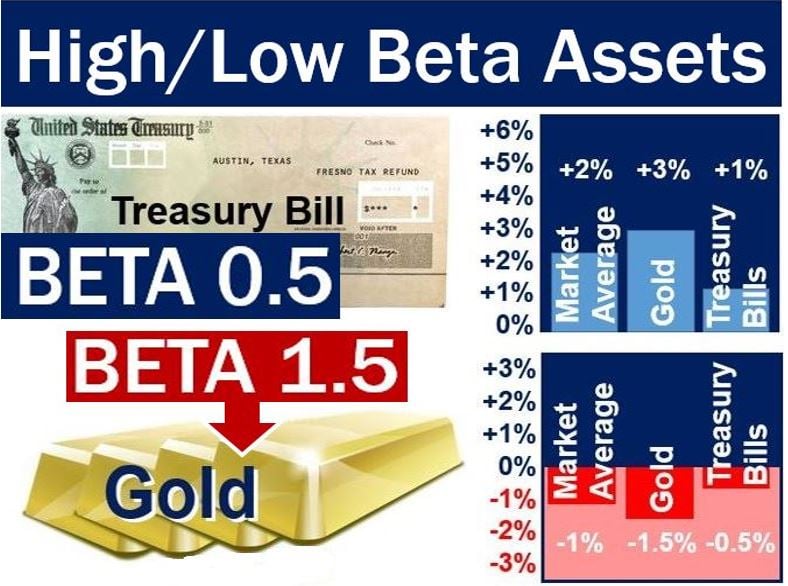The Beta, Beta Coefficient, or β of an investment is a financial term that indicates whether an investment fluctuates more or less than the market average. In other words, it tells us whether an investment is more or less volatile than the market average.
A β of more than 1 suggests that the investment is more volatile than the market. On the other hand, if it is less than 1, it indicates a below-market volatility. ‘Below-market volatility’ means the investment is likely to fluctuate in price less than the market average.
We measure volatility as the fluctuation of the price around the standard deviation, i.e. the mean.
β is a measure of the risk of an asset in relation to the market. For example, the market might be the S&P500 in the US, the FTSE 100 in the UK, or the CAC 40 in France. Additionally, we can compare the investment with an alternative benchmark or other factors.
Important issues when using Beta
When using β, there are several factors the investor needs to be aware of:
- Through time betas may change.
- Depending on the direction of the market, βs may be different. In other words, they might be greater for downward movements in the market rather than upward movements.
- If the investment does not frequently trade, there will be a bias in the estimated βs.
- The investor may need multiple βs to have a complete measure of risk.
According to NASDAQ’s glossary of terms, the Beta is a measure of co-movement and not volatility. An investment might have a zero β and greater volatility than the market.
Beta is a measure of risk that arises from exposure to general market movement rather than idiosyncratic factors. Idiosyncratic risk refers to the risk that affects just one company or sector.
The market portfolio of every investment combined has a β of precisely 1.

Let’s assume that gold and treasury bills have a beta of 1.5 and 0.5 respectively. Therefore, they will go up and down 50% more and 50% less respectively than the market average. If the market average rises by 2%, Gold will rise by 3% and Treasury Bills by 1%. If the market average falls by -1%, Treasury Bills will fall by -0.5% and gold by -1.5%.
The Betas of treasury bills vs. gold
A treasury bill, for example, has a price that does not fluctuate much. Therefore, treasury bills have low βs. Gold, on the other hand, is susceptible to swings. In fact, gold’s fluctuations are sometimes large. Additionally, the fluctuations do not necessarily move in the same direction as or simultaneously with the market.
If a β is greater than one, it means that the asset is both volatile and has the tendency to move up and down with the market, For example, stocks in large tech firms have a β greater than one. However, negative βs may tend to go down when the market is rising, or vice-versa.
Some fundamental investments have consistent and significant negative Betas. However, some derivatives such as put options may have large negative Betas.
For example, an investment with a Beta of 0.75 will probably fluctuate by 0.75% if the market fluctuates by 1%.
Which betas do investors prefer?
Investors like to hold onto low-β stocks or defensive stocks when the market is particularly volatile. Investors also tend to hold onto low-β stocks when markets are declining.
High-β stocks become more popular when the market is on a steady rise. When markets are rising, investors are more willing to take risks.

Other meanings Betas
In lay or technical English, the term has dozens of different means. Here are a few of them:
Technology and Computing
1. The release of betas occurs before their official releases. We commonly use the term for software in the development stage.
2. BETA is a programming language.
3. The term may also refer to the common-emitter current gain of a bipolar junction transistor.
Biology
1. Social animals have different ranks. For example, the alpha female in a pack of hyenas is the leader. The beta females are below the alpha.
2. A beta-endorphin is a type of neurotransmitter.
3. A beta cell is a type of cell in the pancreas that produces insulin.
4. A beta is a genus of flowering plants. We usually refer to them as beets.
5. A beta grape is a North American variety of grape.
Physics
1. Beta velocity is something’s speed relative to the speed of light.
2. The term may refer to the ratio of thermal to magnetic pressure in plasma.
3. Beta function is a function in quantum field theory.
4. Beta particles are high-energy electrons or positrons that certain kinds of radioactive nuclei emit.
Mathematics & Statistics
1. β refers to the likelihood of a Type II error in statistics.
2. β-reduction is a reduction rule for lambda calculus.
3. In statistics, beta distribution is a family of continuous probability distributions.
